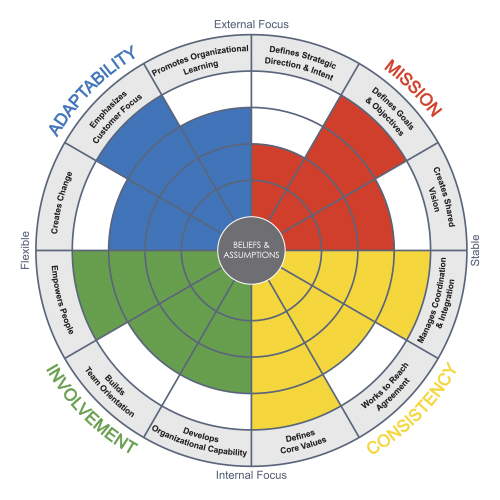Leadership Eats Culture
By Bryan Adkins Ed.D., CEO, Denison Consulting
It wasn’t long after starting my career in the corporate culture arena that I came across the quote “Culture Eats Strategy.” It has been attributed to a few people, most often to Peter Drucker. Regardless of its origin, the quote is one that resonates with many. We’ve witnessed many an organization where the strategies were sound, yet ultimately failed as a result of a culture that sabotaged (either explicitly or implicitly) the execution.
Employees from every level and in any part of an organization can play the role of saboteur. Yet no one is so well-positioned to undermine the efforts of the organization than those in leadership roles. Yes, culture does eat strategy. However, leadership eats culture. As our founder, Dan Denison, noted in the book, “Leading Culture Change in Global Organizations”: “It is very tempting to sit at the top of a successful global corporation and contemplate your strategic options. But it is equally humbling to listen to the office chatter on the front line and realize how little impact your most profound strategic insights have on the day-to-day actions of your people.”
Among the many insights that we often discover when doing our culture work are the differing culture perceptions based on level, region/location and function. The lack of alignment across an organization becomes quite clear.
It is also quite common to be looking at a range of culture profiles and have people say things like, “Oh, no surprise there… that’s Cindy’s group” or “That region’s results make sense. They’ve struggled under Steve’s leadership.” Intuitively, they are making a connection between a leader and the culture that leader oversees.

Who is Responsible?
Let me clarify that I absolutely believe that all members of an organization should own the culture in which they operate. Viewing the culture as someone else’s responsibility is fraught with implications, including unrealistic expectations of others, ambivalence towards the importance of the work environment, and the adoption of a victim mentality. Culture is about the collective, not the individual. One person does not a culture make, though as noted earlier, leaders are uniquely positioned to have a disproportionate impact on the way things get done in an organization.
Leaders play a critical role in setting priorities and determining where employees focus their efforts. They are in a position to help employees understand why those are the priorities. Resource allocation, budgets, hiring and firing, investments…leaders can and usually do influence all of these decisions. Leaders also react to successful initiatives as well as problems and mistakes. Those reactions send explicit messages, not only about what is working well, but also how to respond to successes and failures.
How do Leaders undermine the Culture?
There are countless ways in which a leader can undermine a culture. Speak skeptically about a strategy and employees may question just how serious the strategy is or how committed is the leadership. Behave in ways that are in clear violation of the core values – what are supposed to be the non-negotiables – and the values become, well, valueless. Disparage the customer and before you know it the customer is viewed as an inconvenience. Berate the employee who brings forth new ideas and challenges the status quo and “change” becomes a dirty word. React to a mistake by first asking, “Who is to blame?” vs. “What can we learn?” and fear becomes a dominant force.
“Speak skeptically about a strategy and employees may question just how serious the strategy is or how committed is the leadership.”
Leadership through
a Culture lens
a Culture lens
At Denison, we look at leadership through a culture lens. Our research has shown how culture impacts organizational performance across many critical metrics. Given the consequential impact of culture, it seems only logical that culture awareness and culture management should become a core competency of every leader and manager. In recent years, the topic of culture is at the top of nearly every list of executive concerns. So how do you make culture something that every leader can be aware of and take responsibility for?
Another Peter Drucker quote is: “You can’t manage what you can’t measure.” The assessment of both the organization and leaders through a high-performance culture lens is a powerful force for change. An organizational culture assessment allows you to see just how clear and aligned the workforce is and to parse that information across functions, levels and locations to identify where disconnects might exist.
Leadership 360 feedback, using a culture lens, allows every leader to see how well they are creating clarity and alignment among their key stakeholder groups. The very act of measuring leadership using a culture model sends a very powerful message to leaders and managers. It says that culture is important and that you have an obligation as a leader to understand and manage your impact on the culture.

Make Culture a Leadership Priority
If culture understanding and management is a priority for your organization,
start by asking yourself the following questions:
At Denison, we have developed an integrated suite of products and services designed to help organizations answer such questions and develop a robust culture change and development solution. Culture and leadership can be measured and managed.

Conclusions
A misaligned culture can be voracious in appetite. It can sabotage the most thoughtful and elegant of strategies. Leaders who are quick to blame the culture of their organization for the failure to execute on those strategies should take a careful look at their own impact on the culture. Yes, culture is about the collective and everyone is ultimately responsible for the way work does, or does not, get done. But a leader who creates ambiguity, skepticism and fear will spread that mindset like a virus. Unchecked, that leader will eat the culture and likely devour the strategy as well.
“A leader who creates ambiguity, skepticism and fear will spread that mindset like a virus.”
Bryan Adkins is the CEO of Denison Consulting.

